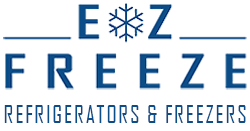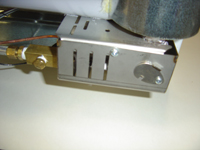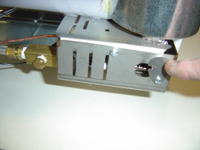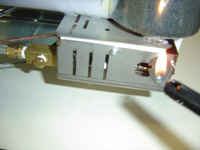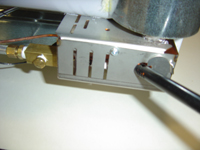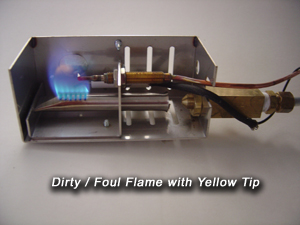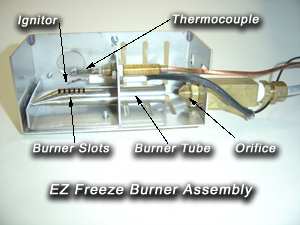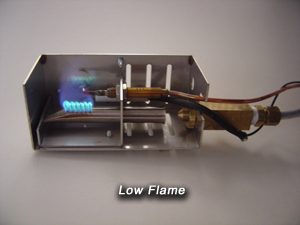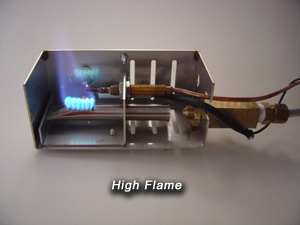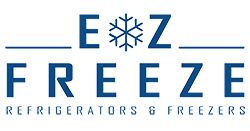Troubleshooting a gas refrigerator
Will Not Light
First time start-up lighting difficulties may result from air in the gas line. Be patient with the lighting procedure since the gas orifice hole is very small on these units, so it may take several minutes to bleed the air from the gas lines. This is exaggerated even more if this is new construction and the gas lines have never been used.
Be sure the Piezo Ignitor is making a snapping sound when pushing it in. If not, then the Piezo Ignitor may be defective. Replace.
If the above items check OK, then check to be sure that the Spark Electrode is creating a spark at the Burner Slots when the Piezo Ignitor is pushed. You should see a spark jump the gap between the Spark Electrode and the Burner Tube at the moment that the Piezo Ignitor makes the snapping noise. The spark electrode should be clean and positioned approximately 1/8″ to 3/16″ above the burner tube. See picture below.
You may hand light the unit with a lighter by holding the lighter flame at the Burner Slots while proceeding with the below instructions. This process takes 2 persons. Person 1 must do the following;
- Turn on the gas valve at the rear of the refrigerator
- To start the refrigerator, turn the thermostat knob “Temp” (Thermostat) to the #2 setting
- Push and hold “Gas” (Gas Safety Valve) button, and then…
Person 2 must follow the below sequence…
Will Not Stay Lit
If the burner lights but does not stay lit after you release the Safety Valve “Gas” Button, then retry and hold the button on longer. If it still does not stay lit, then the Thermocouple may be dirty, loose, or defective. Clean any carbon deposits from the end of the Thermocouple with a soft wire brush. Check the connection of the thermocouple at the back of the Safety Valve body. This will require a 5/16″ or 8mm wrench. If the above checks out but does not fix the problem, then replace the thermocouple. Be sure to adjust the thermocouple into the flame the same amount as the original.
Fridge is too Warm
There are many reasons why the refrigerator compartment temperature may rise.
- Ambient air temperature rises.
- Humidity increases.
- Usage (door openings) increases.
- Loading with large quantity of food.
For any of the above, adjust the thermostat control to a higher number (turn clockwise) and recheck the refrigerator compartment temperatures the next morning.
Other reasons include the following;
- Insufficient ventilation. See the Ventilation section.
- Refrigerator not level. See the Leveling section.
- Condenser fins dirty. See the Cleaning section.
- Refrigerator needs defrosting. See the Defrosting section.
- Low gas pressure. See the Gas Pressure section.
- Yellow (Dirty) Flame. See the Yellow Flame section.
- Faulty thermostat. Call serviceman to replace.
Refrigerator not cooling at all
- Flame is out. Propane supply is depleted. Wind gust blew the flame out. Faulty thermocouple. Dirty burner.
- Faulty thermostat. Call serviceman to replace.
- Failed cooling unit. Call serviceman to replace.
Exhaust Fumes Smell
Odor from the flue pipe is usually caused by a dirty flame. See the Yellow Flame section and Clean the Burner section
Strong Odor
If an ammonia smell is detected and no cleaning solution with ammonia has been used recently, then it is possible that the sealed absorption system is leaking. Call a serviceman.
Flame is Yellow….
The most common cause of a propane gas refrigerator not functioning properly is due to a dirty flame. This is the product of debris getting into the burner tube. Debris such as insects, lint, hair, or dust build-up are most common. The Burner Tube is easily cleaned out with high pressure air by simply blowing from the Burner Slots toward the Burner Air Intake side. Once this is accomplished, the flame should burn clean and crisp. If the flame has been burning dirty for any period of time, be sure to also clean the flue and baffle. See the Cleaning Flue and Baffle section.
The Proper Flame should look like the below images. High Flame will occur when the unit is chilling down to the set thermostat temperature. Low Flame will occur when the unit is at the set thermostat temperature. The thermostat automatically switches from high to low flame in order to maintain the correct set temperature determined by the setting of the thermostat “Temp” knob.
